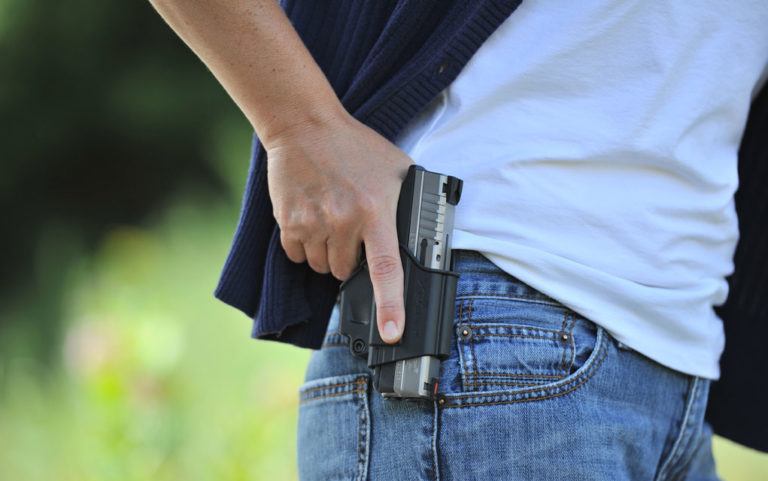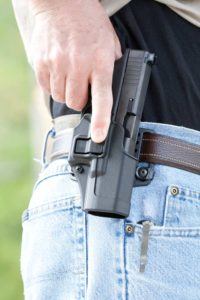
Procedural tactics regarding the safe holstering of a handgun have changed dramatically over the years. Here are some things to know.
- Shooters should of course keep their fingers off the trigger when holstering.
- Another trick is to place the thumb on the hammer of hammer-fired guns.
- If the hammer is up on a 1911-style pistol, it prevents it from falling.
- If it is down on a double-action pistol, it prevents it from rising and then falling.
- The author suggests looking the gun into the holster at the learning stage.
- Later, a more experienced shooter should be able to holster without looking.
There have been some new trends in the past few years on safe holstering doctrine.
In the old days, when holsters left triggers and trigger guards exposed and it was the custom to put one’s finger on the trigger as soon as the hand hit the holstered gun, any snag in the draw could result in the practitioner shooting himself, usually in the leg. Eventually, the gun world learned to demand holsters that covered the trigger guard area to prevent that. The change was good as far as it went, but in a sense it simply redistributed the nature of the negligent discharge. Now what happened was, when the finger was carelessly left on the trigger, the gun went back into the holster and the trigger finger stopped on the edge, and the gun kept moving and – BANG! A self-inflicted gunshot wound remarkably like the one from the old holster days.
 The mantra of “keep your booger hooker off the bang switch” turned out not to be enough. I’ve seen cops who kept their belt-mounted key ring in front of the holster where, with movement or even previous strenuous activity, a key could wind up on the edge of the holster in line with the incoming trigger during holstering. There was one famous case of an old, soft leather holster bending enough that when a man inserted his Glock into it, the fold of leather hit the center of the trigger and the pistol discharged.
The mantra of “keep your booger hooker off the bang switch” turned out not to be enough. I’ve seen cops who kept their belt-mounted key ring in front of the holster where, with movement or even previous strenuous activity, a key could wind up on the edge of the holster in line with the incoming trigger during holstering. There was one famous case of an old, soft leather holster bending enough that when a man inserted his Glock into it, the fold of leather hit the center of the trigger and the pistol discharged.
One of the biggest offenders is the drawstring found on warm-up jackets, hoodies, some winter coats and similar garments. We are seeing those get fouled between trigger guard and holster every year! DRAWSTRINGS ARE INCOMPATIBLE WITH HOLSTERED GUNS AND UNSAFE TO WEAR WITH THEM! IF YOU CARRY A GUN, REMOVE THE DRAWSTRINGS!
It only makes sense when we are dealing with deadly weapons to put safety net after safety net in place. One that I learned early was THUMB ON HAMMER WHEN HOLSTERING. If something trips the trigger, the thumb on the hammer of a cocked 1911 or similar pistol holds that hammer back, and prevents it from firing the shot. If the hammer is down on a double-action weapon, the thumb holds it down, so it cannot rise and fall and crack off a shot. Even with an unmodified striker-fired pistol, the thumb holds the slide forward so a tight-fitting holster can’t push it out of battery, and guarantees that when the gun comes out, it is ready to fight for you.
During this same process, the trigger finger should be straight. The index finger is known colloquially as the “pointer finger,” and this helps get the gun smoothly into the holster. It also, of course, guarantees that the finger wasn’t left on the trigger during the holstering process.
As I said, I’ve been practicing and teaching this since the 1970s, and published it in 1984 in my book StressFire. No one who has followed this protocol has shot himself yet. Enough said.
Latest Re-Holstering Doctrine
Because some people have shot themselves holstering, a new mantra has emerged: Look the gun into the holster, so you can see what you are doing. Another mantra is, “You never need to holster quickly, just to draw quickly. ALWAYS holster slowly and carefully.”
By and large, that’s good advice…but “always” can be a bigger word than it looks. We need to talk.
 Full time police work only 40 hours a week not counting overtime, and there are 168 hours in a week, so every cop is off duty more than he or she is on. (As a part time cop for 43 years, I was off duty even more.) Off duty cops, or plainclothes officers, or armed citizens when they’ve had to pull a gun on the street against criminals, will be unidentifiable as Good Guys and Gals when the uniformed cops pull up. Those cops have been told “Person with a gun, there now.” The Good Guy or Gal is “Person with a gun, there now”! It behooves them to get that gun put out of sight quickly and smoothly, without taking their eyes off the person present who was so dangerous they had to pull a gun on him in the first place.
Full time police work only 40 hours a week not counting overtime, and there are 168 hours in a week, so every cop is off duty more than he or she is on. (As a part time cop for 43 years, I was off duty even more.) Off duty cops, or plainclothes officers, or armed citizens when they’ve had to pull a gun on the street against criminals, will be unidentifiable as Good Guys and Gals when the uniformed cops pull up. Those cops have been told “Person with a gun, there now.” The Good Guy or Gal is “Person with a gun, there now”! It behooves them to get that gun put out of sight quickly and smoothly, without taking their eyes off the person present who was so dangerous they had to pull a gun on him in the first place.
If the Bad Guy goes for a gun at that moment and you are “looking your gun into your holster,” the gun and holster may be the last thing you see before your world goes dark forever. And that doesn’t take into account the situation many cops have faced: they have the bad guy at gunpoint, the bad guy gets physical, and they decide not to shoot him but need both hands to restrain him. That gun has to be put away swiftly and surely and rather quickly, without taking the eyes off the threat.
So…this writer suggests that you look the gun into the holster ALWAYS in the learning stages, because the eyes tell the hands what to feel, and that’s the shortcut to being able to do it by feel. Don’t do it fast so much as you do it smooth, and when the proverbial “need for speed” comes, you’ll more likely be able to do it quickly by feel, even in total darkness. You DO want to be able to holster one-handed by feel. It’s an important tactical skill.
More Tips For Safe Re-holster
My colleague and friend, master instructor David Maglio, popularized the technique of clicking one’s heels together when holstering at the hip. It keeps the gun side leg out of line of the muzzle.
I like to step forward with my holster-side leg, or back with the off-side leg, for the same reason when I holster.
When holstering on the front of the body (i.e., AIWB), cantilever the upper body back at the hips, so the muzzle will at least point forward past genitalia and femoral arteries.
Editor's Note: This article is an excerpt from Gun Digest Book of Concealed Carry, Volume 2: Beyond the Basics.

Next Step: Get your FREE Printable Target Pack
Enhance your shooting precision with our 62 MOA Targets, perfect for rifles and handguns. Crafted in collaboration with Storm Tactical for accuracy and versatility.
Subscribe to the Gun Digest email newsletter and get your downloadable target pack sent straight to your inbox. Stay updated with the latest firearms info in the industry.

![Best Concealed Carry Guns In 2025 [Field Tested] Wilson Combat EDC X9S 1](https://gundigest.com/wp-content/uploads/Wilson-Combat-EDC-X9S-1-324x160.jpg)


![Best 9mm Carbine: Affordable PCCs [Tested] Ruger Carbine Shooting](https://gundigest.com/wp-content/uploads/Ruger-Carbine-Shooting-100x70.jpg)
![Best AR-15: Top Options Available Today [Field Tested] Harrington and Richardson PSA XM177E2 feature](https://gundigest.com/wp-content/uploads/Harrington-and-Richardson-PSA-XM177E2-feature-100x70.jpg)

Just did an experiment.
Unloaded the 45, and played with putting the gun into the holster.
The excellent news about Governments is that the hand position to hold the hammer with the thumb while holstering pulls the web of the thumb / index finger far from the grip safety, making it extremely unlikely that the trigger can be activated by clothing, holster, keys, etc. But you should not actually pull the hammer back during this action, as pulling the hammer back will trip the grip safety, causing the hammer to fall.
Second, If the hammer is released while the trigger is pulled and the grip safety is activated, releasing the grip safety before the hammer hits the firing pin will not stop the hammer from hitting the pin. Releasing the trigger will.
From MAG40, I’ve been actually pulling the hammer back on the 45 while holstering. This is not a good idea. Thumb on the hammer, but not moving the hammer is the better way to fly.
Is there a reason why the hammer pulled all the way back hits the grip safety, and deactivates same? Why not limit the hammer travel back to keep it from hitting the grip safety, or milling a hole in the safety so the hammer does not hit it?
Mas.
If you are holstering a government 45 with your thumb on the hammer, is it obvious when the trigger has been pulled during the holstering effort, and what is the proper next step to prevent discharge? Recock the hammer with the gun in the holster? Remove gun with thumb holding hammer, point in a safe direction that will stop bullets, and recock? Or lower the hammer in both cases? Or just pull the web of your hand away from the grip safety?